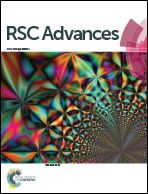Reduction of thermal conductivity in dually doped ZnO by design of three-dimensional stacking faults
Abstract
A design paradigm for fabrication of high quality thermoelectric material was demonstrated by using wurtzite ZnO based materials. To prepare the three-dimensional stacking faults in the microstructure of ZnO, Ga2O3 and In2O3 which were guided by atomistic simulation were selected as doping oxides in wurtzite ZnO. TEM microanalysis experimentally confirmed two kinds of stacking faults which were along the basal-plane (i.e. {0001}) and pyramidal-plane (i.e. {10–14}) in the microstructure of ZnO dually doped with small amount of Ga2O3 and In2O3. Also, EDS analysis results indicated the dopant segregation effect at stacking faults which was predicted by our atomistic simulation results. By varying doping levels, it was found that the (Ga0.004, In0.004)Zn0.992O with dense three-dimensional stacking faults revealed low lattice thermal conductivity (1.7 W m−1 K−1 at 773 K) and high thermo-electric performance (ZT: 0.19 at 773 K) in the present work. Based on all experimental results, it is expected that the combined method of atomistic simulation, microanalysis and processing route design will provide us great opportunity for design of three-dimensional stacking faults in the microstructure of ZnO with high performance.


 Please wait while we load your content...
Please wait while we load your content...